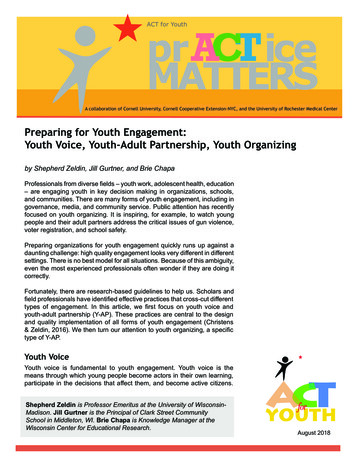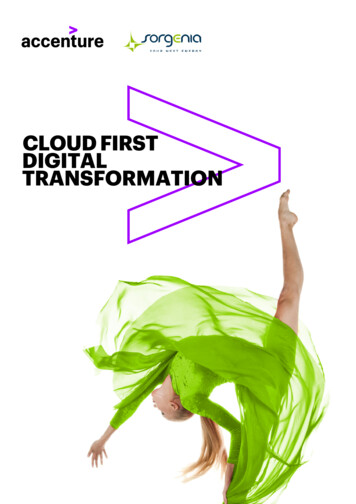
Transcription
2017ORGANIZINGFORSUCCESSHOW BUSINESSES ARE RE-STRUCTURINGFOR MARKET SHARE
22017 ORGANIZING FOR SUCCESS2017 ORGANIZINGFOR SUCCESSAs the digital experience becomes anessential part of doing business, leadershipteams around the world in nearly everyindustry are building and optimizing theirdigital organizations to help meet aggressivebusiness goals and respond to increasinglydynamic market trends. While somebusinesses have made major investments inadapting their structure, operating model,and skilled resources to advance their digitalagendas and are seeing the benefits, there arestill several challenges to address for so many.To dig deeper into these challenges and uncover potential solutions, wesurveyed more than 200 digital executives to understand the key trends,variances, and challenges businesses are facing in the age of the cross-channelcustomer experience. All respondents came from companies with more than 1B in revenue across 11 countries in both digitally mature and digitally emergingmarkets around the globe. Emerging markets are definedas those located within India and Brazil, while mature markets consist of Australia,Canada, China, France, Germany, Korea, Japan, United Kingdom and UnitedStates. For this report, we identified "market leaders" as companies reportingmore than 75 percent of total revenue coming through digital.Additionally, we benchmarked several data findings from our 2015 Organizingfor Successi report, which identified how leading edge organizations in the USare using digital to grow and achieve business goals.The results revealed four key themes that are shaping the digital landscape.MARKETLEADERS 75%OF TOTAL REVENUEIS DIGITAL
32017 ORGANIZING FOR SUCCESSFOUR KEYTHEMES1. Digital revenue continues to grow, with emergingmarkets quickly catching up to mature ones in bothsales and the team structures required for support.Notably, digital leaders are laser focused on what is drivingtheir profitable customers, while still delivering a consistentexperience to all of their customers.Emerging markets have made significant digital gainsover the last several years. Mature markets are still leadingthe pack, but findings indicate it won’t take emergingmarkets as long to get up to speed as initially expected.What’s more, our data shows there aren’t major differencesin digital revenue among the large organizations selectedfor this study, indicating the speed and necessity of digitalgrowth is consistent across the board. From manufacturingto retail to consumer packaged goods (CPG), industriesare investing in digital portfolios, platforms and teams toremain competitive.2. Leadership structure, operating models, and vendorpartnerships tend to skew towards a more fullyintegrated and centralized digital strategy.Executive support is critical, and both emerging andestablished markets agree that the CEO is ultimatelyresponsible for digital growth. But the full executive suite mustwork in tandem in order to become a truly digital organization.Some notable changes year-over-year in the US includeincreased adoption of a fully-integrated digital operatingmodel and the increase in outsourced digital work.3. Recruiting in a competitive market and up-skillingcurrent employees remain challenging.Easing the difficulty of recruiting, training and retainingskilled employees remains a steady priority, and companiesaround the globe find the competitive landscape a topchallenge. In response many businesses are focused ongrowing the skills of their current teams.4. The cross-generational workforce of millennials andGeneration X is providing the right mix of innovation andpragmatic execution to continue digitally-powered growth.Each generation adds unique value to companies’ digitalunits. Businesses are looking to digitally-minded millennialsto bring unique, forward-thinking solutions to the problemsthey face, while the established workforce tends to leadwhen it comes to creating a well-balanced team.This report dives deeper into how businesses across industries(and oceans) are growing and fine tuning their digitalorganizations to align with business goals and changingmarket trends.
42017 ORGANIZING FOR SUCCESSOUTCOMESWithin the past several years, digital investments have becomecritical to the success of large enterprise organizations. Andbusinesses are seeing notable returns on their new investmentsin leadership, organizational structure and talent recruitmentand skill development. More than 50 percent (54 percent) oftotal respondents report more than half of their total sales comevia digital channels. For this report, we identified 17 percent ofcompanies as "market leaders" reporting more than 75 percentof total revenue coming through digital.This growth of digital revenue is being largely driven by certainindustries and geographies (see Figure 1), some of whichhave successfully adapted their businesses to accommodatethe digital experience faster than others. Today, thecommunications, media and technology industry is seeing themost return on investment. Nearly three fourths (73 percent) ofrespondents in this industry report more than half of their totalsales are digital. Two other industries where respondents hadclose to half of their revenue coming from digital channels were:manufacturing (51 percent) and retail (47 percent).Respondents in the US now see half of sales (49 percent) comethrough digital channels. That number has grown since 2015,when only one in four US respondents reported half of salescoming from digital channels. That said, digital revenue still doesnot make up the lion’s share of total revenue for many marketsand industries. Europe lags behind the average by nearly 15percent, with only 40 percent of respondents reporting morethan 50 percent of their revenue flows through digital channels.Note that this survey focused on larger enterprises where it’s notinconceivable that they would be experiencing more channelshift than other enterprises – shifting the top of the sales pyramidcan result in significant swings in digital percent of sales.Figure 1: More than half of total sales are digital by region40%EUROPE54%AMERICASSource: Accenture 2017 Organizing for Success62%APAC
52017 ORGANIZING FOR SUCCESSA MIX OF ONLINE REVENUE CHANNELSTo help achieve this success, organizations conduct digital salesvia multiple markets, consisting of business-to business (B2B),direct business-to-consumer (B2C), and third-party marketplaces.Overall, digital sales are evenly distributed across these markets(see Figure 2), with a quarter of total respondents reporting 40 to60 percent of digital sales are B2B, B2C, and through third-partymarketplaces. Consumers desire to transact online in both theirpersonal and professional lives, and businesses that can providefor both are seeing notable gains in revenue.B2B in particular is expected to experience significant growth indigital advancement over the next several years. Today, directdigital sales to a business or organization drive at least 40 percentof sales for 42 percent of respondents. By 2020, B2B digitalcommerce is expected to reach 1.13 trillion.ii This speaks volumesabout the maturation of digital adoption within the B2B industry,which has traditionally lagged behind its B2C counterpart.When broken down by region, North America drives the mostdigital sales from B2B transactions, with 51 percent indicating thatB2B sales drive at least 40 percent of their revenue, followed by45 percent of European respondents. The Asia-Pacific (APAC)regions lag behind, with only 28 percent reporting B2B salesdriving at least 40 percent of their digital sales.As B2B industries such as manufacturing move their businessesonline, there is a unique opportunity to sell downmarket to helpincrease profit gains and use digital to optimize existing salesand fulfillment support to scale without increasing cost. Weexpect this business model will become more pervasive in theyears to come.Figure 2: What percentage of your digital sales fall into the following : Accenture 2017 Organizing for Success40-60%Third-party marketplace60-80%80-100%
62017 ORGANIZING FOR SUCCESSHOW ORGANIZATIONS MEASURE SUCCESSNew and emerging markets should look to market leaders forguidance on ways to track and measure success (see Figure 3).Digital traffic is still a popular metric (63 percent), but it is not theprimary metric used by market leaders. They focus on top-linemetrics such as digital revenue (75 percent) and digital share ofmarket (70 percent).Overall, these KPIs are consistent with the general respondentfindings. Slight variations exist for emerging markets, which tendto track digital share of market more than in established markets,which is likely to ensure as early entrants they command themarket. They are not tracking the ratio of digital costs to digitalrevenue like their established market peers, which demonstratesthe known investment needed to gain market share.Market leaders (55 percent) measure who their highest-valuecustomers are and focus on growing those customer segmentsnearly 20 percent more than the survey average. Smaller andemerging markets struggle to effectively measure their businessresults this way due to limited volume and scale, but will becomeincreasingly more important as these companies growth theirdigital business.Figure 3: Which of the following are key performance indicators (KPIs) measured for your digital organization?0%10%20%30%40%50%60%70%7574Digital revenue70Digital share of market6063Digital traffic6055Ratio of digital coststo total revenue4955Customer groups ranked fromhigh to low digital revenue3447.5Offline sales fromdigital customers3937.5Cart abandonmentNo digital-specific KPIsin placeLegend2212.59Market leadersAll respondentsSource: Accenture 2017 Organizing for Success80%
72017 ORGANIZING FOR SUCCESSORGANIZATIONDIGITAL GROWTH ACCOUNTABILITYExecutive support is critical to making digital a priority andmeeting business KPIs. More than a quarter (28 percent) ofrespondents said the CEO is responsible for digital revenuegrowth and almost three quarters of respondents (72 percent)said responsibility lies with either the CEO, CIO or CDO (seeFigure 4). When it comes to market leaders, 40 percent ofrespondents cite the CEO, and 73 percent cite the CEO, CIO orCDO as responsible for digital revenue growth.When it comes to relying on digital-specific executives to drivesales through digital channels nearly one in four (22 percent)indicated the CDO is responsible for digital revenue growth.Looking closer at where CDOs are employed (see Figure 5),APAC leads with 85 percent, followed by Europe at 52 percentand North American at 49 percent. The breakdown of CXO andCCO remains consistent across regions.Both emerging and established markets agree that the CEO isultimately responsible for digital growth, but mature marketsFigure 4: Who is responsible for digital revenue growth?Our research indicates that organizations are taking theright steps to implement the leadership necessary to helpdrive more digital sales. However, to become a truly digitalorganization, these roles must work in tandem. Fifty-six percentof respondents said their CDO, CXO and CCO work as acollaborative unit with the CIO and CMO, making crucialdecisions as a team. Still, about one in three (33 percent) saidthey still make digital decisions independently and are often atodds with each other. Unfortunately, waters are often muddywhen it comes to budget allocation and investment prioritiesacross new and established leadership roles. Businesses mustwork in the years ahead to ensure that management becomesmore collaborative across departments.Figure 5: Does your company currently have a CDO?90%Chief Digital Officer (CDO)22.370%Chief Information Officer (CIO)22.360%12.2Chief Marketing Officer (CMO)Direct report to other C-Suite3.8Director3.3Chief Customer Officer (CCO)50%40%4980%5227.885Chief Executive Officer (CEO)place more responsibility on the CIO (24 percent) than thosefrom emerging markets (12 percent). This gap is likely dueto mature markets forming digital units when digital was stillowned by the CIO. Emerging markets essentially missed thisphase as most of these companies were formed within the lastthree to four years.30%20%2.910%0%Chief Experience Officer (CXO)2.1SVP1.6VP1.2Source: Accenture 2017 Organizing for SuccessAPACEuropeNorthAmerica
82017 ORGANIZING FOR SUCCESSTHE SIZE OF DIGITALORGANIZATIONSTEAM STRUCTUREThe size of the digital teams that leaders are tasked with managingis directly correlated to the percentage of digital revenue theygenerate. In short, the larger the digital team, the more digitalrevenue they see. One third of total respondents have more than200 employees on their company’s digital team (see Figure 6)compared to more than half (55 percent) for market leaders.Digital teams are also getting larger, with more than half(56 percent) of respondents employing teams larger than100 people and a third employing teams larger than 200 people.That said, the majority of mature market respondents tendto have teams smaller than 100 employees, and the US leadswith 61 percent having teams smaller than 100 employees.This is because mature markets are more likely to have accessto sophisticated vendors and partners rather than execute inhouse. This smaller size is also attributable to organizing as aDigital Center of Excellence (DCoE). In countries that favoreddecentralization (Japan and France), the digital teams were inexcess of 200 people.Due to the large percentage of digital revenue communicationsand media technology businesses generate, it’s unsurprising thatthis industry has the highest percentage of digital organizationsthat employ more than 200 people. Forty-two percent ofrespondents in this industry work on a team of 200 or moreemployees. On the other hand, the retail industry, which istraditionally challenged with tight margins, reports just 18 percentof teams employ a staff of 200 or more. The majority (63 percent)of retailers have less than 100 employees on their digital team.Aside from beginning to employ the right leaders to drivedigital sales, organizations are also intentionally structuring theiroperating models to increase potential. The most commonoperating model today is the DCoE, which provides expertise andstandards and supports strategy development for focus areaswithin the organization. Thirty-seven percent of respondentsoperate in a DCoE model. Almost half (48 percent) of emergingmarket respondents identified their organizational structureas a DCoE, compared to just 33 percent of mature marketrespondents. Over half of the of market leaders are eitherfollowing the use of a DCoE model (35 percent) or are already fullyintegrated (17.5 percent).A fully-integrated model in which all functions are digitallyenabled and the experience is managed holistically across touchpoints is a more mature model. In the US, the percentage oforganizations who have completely adopted a fully-integratedmodel doubled since 2015 (16 percent in 2016 vs. 8 percent in2015), indicating the increasing focus on digital as companiesrestructure their organization.GEOGRAPHIC LOCATIONThe most popular additional location for a digital team outsideone’s home country base was the UK (53 percent). The US wassecond with 37 percent. Rounding out the top five were Canada(30 percent), Australia (24 percent) and Germany (22 percent).Figure 6: How many employees are in your digital team?33.840%30%0%Less than1011-2526-50Source: Accenture 2017 Organizing for .320%151-200More than200
92017 ORGANIZING FOR SUCCESSHOW BREXIT COULD IMPACTDIGITAL SATELLITE OFFICESAfter the UK left the European Union (EU) with the recentBrexit vote, there are questions if the UK will remain a popularinternational location. Potential new trade tariffs, privacyconcerns with transmitting data from the UK to the EU, andnew work visa restrictions may add complexities to the task ofstaffing a digital team that can support Northern, Southern, andCentral Europe. While implications will take at least three yearsiiito materialize, the uncertainty may prompt organizations toconsider alternate EU-member country locations, such as theNetherlands, France or Germany.Emerging market organizations are more likely to use multiplevendors to complete digital workloads because there maynot be strong vendors who offer the breadth of experience totake on all of their digital needs. Sixty-five percent of emergingmarket respondents reported using more than 10 partners,compared to 46 percent of those from mature markets.Additionally, 50 percent of emerging market respondents useexternal partners for more than half of their work, compared toonly 29 percent of mature markets. These differences demonstrateemerging market organizations are looking to grow and keeppace with mature markets while not previously having a digitalorganization. However, our experience shows that fragmentingthe work across multiple partners often leads to confusion andinefficiencies, and leads to broken experience for customers.VENDORS AND PARTNERSAs more companies are realizing the challenges of outsourcingto a large number of vendors, the number of digital vendorscompanies are utilizing is decreasing (see Figure 7). Nearly threein four respondents (74 percent) said their organization workswith 20 or fewer digital partners, while 21 percent surveyed saidthey work with less than five. A majority of US respondents tendto work with fewer than 10 partners (59 percent).That said, the amount of work being outsourced is not declining.One third of respondents outsource more than half of their digitalwork. US respondents are outsourcing even more of their digitalworkload than they did last year (22 percent in 2016 vs. 16 percentin 2015). These organizations are looking to sophisticated vendorsthat provide a comprehensive set of digital offerings.Figure 7: What percentage of your overall workload (in the digital organization) do partners perform?0%Less than10%7.210%5.120%10%-25%Source: Accenture 2017 Organizing for than 90%
102017 ORGANIZING FOR SUCCESSRECRUITING AND RETENTIONFACTORSTHE MILLENNIAL FACTORRecruiting and retaining top talent poses another challengefor businesses (see Figure 8). The competitive landscapeposes a unique problem for organizations trying to gain marketshare, with more than half (51 percent) reporting it as their topchallenge when it comes to recruiting and retention (51 percent),followed by the talent pool (45 percent) and lack of experience(41 percent).One way businesses are dealing with the competitive job marketand scarce talent pool is by growing the skill sets of their currentteams. When asked about talent, training current employeesranked as a top priority at 65 percent. Less than half (47 percent)say they are primarily focused on hiring new talent.Emerging markets are taking a different approach by prioritizinghiring new talent (62 percent) over training current employees.These organizations may still be focused on growing theirexisting teams with fresh skills and knowledge in order toincrease their market share.Finally, while most respondents said they are primarily focusingon training new talent, 37 percent would rather hire newemployees with a certain skill set than train current employees.The communications, media and technology respondents stoodout at 51 percent.Digitally-minded millennials are a critical resource fororganizations that are looking to bring in new talent (particularlythose within emerging markets). And those that have hiredmillennials are seeing positive results. Forty-two percent ofrespondents agree that millennials are raising the bar for theirdigital teams, and two in five believe the most innovative digitalideas within their organization are coming from millennials.Although millennials are bringing innovative, fresh ideas tothe table, 37 percent of respondents reported the establishedworkforce provides the practical, realistic and businessresulted oriented ideas. The contrast between creativeideation and pragmatic execution has the potential for positivecollaboration and business gains, but it also can be a source oftension within the organization. At 43 percent US respondentsseem to value the practical, realistic, and business resultsoriented ideas from the established workforce more than theaverage global respondent.What’s more, 56 percent of respondents reported majordifferences in opinion on decisions in the digital departmentbetween the new workforce and more established workforce.A healthy contrast in opinion can be productive forbusinesses, but team leaders must be careful to mitigate anypointless tension.Figure 8: What are the biggest challenges currently facing you and your organization for recruiting and rySource: Accenture 2017 Organizing for SuccessLack ofexperiencePoorperceptionof industryLimited careerPoorpath withinperception oforganizationorganizationNone ofthe above
112017 ORGANIZING FOR SUCCESS
122017 ORGANIZING FOR SUCCESSOPPORTUNITIESSELF-PERCEPTION OF MARKET POSITIONAs companies assess their digital maturity based on the factorslisted above, such as digital revenue, organizational structure,and team leadership, an interesting dynamic is revealed aboutcompanies’ self-perception of their positioning in the market(see Figure 9). Companies are feeling the pressure to make themost of their digital investments because 84 percent feel theirregion is already digitally mature or very mature.These numbers show a change from 2015, in which 27 percentof US respondents listed themselves as sector leaders, but only42 percent said they are on par with sector leaders. Most USbusinesses feel they are at parity with their peers but few seemto think they are actually paving the way. This is noteworthygiven the size the scope of the digital market in the US today.When it comes to digital offerings, organizations generally feelthey are able to keep up with the competition. About a thirdof all respondents (30 percent) feel they are the benchmarkor sector leader (see Figure 10). Specifically in the US, only18 percent of respondents believe their organization is thebenchmark or sector leader, but 60 percent said they are onpar with sector ureImmatureSource: Accenture 2017 Organizing for Success1210%21010%620%2840%3040%58Figure 10: How do your digital capabilities rank relativeto your major competitors?54Figure 9: Which of the following would you identifyas your competitive level of digital maturity?0%VeryimmatureBenchmarkSectorLeaderOn ParTrail
132017 ORGANIZING FOR SUCCESSPRIORITIES FOR IMPROVEMENTOne in five respondents (20 percent) reported digital revenueis a top priority for improvement. More market leaders areprioritizing higher digital revenue than the general population(28 percent vs. 20 percent) showing that they know being aleader is a perilous position if they do not keep pushing formore growth.Customers are the path to growth for respondents. Across theboard, respondents are focused on acquisition (60 percent)and retention (52 percent). To help achieve these goals, worldclass customer experience is the most common priority forimprovement for digital organizations (22 percent).Interestingly, Asia Pacific is more worried about speed to marketthan other countries, with 51 percent saying it more importantcompared to 31 percent of respondents overall.Respondents within emerging markets face greater strugglesgaining executive buy-in for digital initiatives than those frommature markets. 57 percent of emerging market respondentssaid the priority of the digital organization to management wasa challenge, compared to 36 percent of mature markets. As asimilar challenge, 53 percent of emerging market respondentssaid priority of digital delivery to other technology initiativeswas a problem, compared to only 27 percent of mature markets.Understanding the areas of lowest prioritization can be justas insightful as understanding the highest prioritization.Twenty-nine percent of respondents report cost containmentis the least important area for improvement. The lack of focuson cost containment shows that companies realize that digitalstill needs investment to realize the full business opportunity.
142017 ORGANIZING FOR SUCCESSINVESTMENTSDigital organizations are making major investments to addresstheir top improvement priorities (see Figure 11). At the top ofthe investment list are strategic digital initiatives, with half ofrespondents planning to invest in e-commerce or e-businessstrategy in the next six to 12 months. Mobile commerce is alsoa big budget priority in the next year, with half of respondentsplanning to invest there.returning customers place new orders. Domino's has takenconvenience to the next levelv through order enablementby simply tweeting a pizza emoji from a registered Twitteraccount. What’s more, new startups are emerging that makeit easier for retailers to take orders via social. Companies likeReply Yes make it easy to make purchases via SMSvi with aplanned expansion into other message applications soon.Companies are also putting their money towards moreforward-thinking social commerce initiatives, with 44 percentof respondents planning on investing in social commerce inthe next six to 12 months. APAC is the most advanced regionin the world when it comes to social commerce, particularlyChina, which as a mobile-first market has successfully integratedcommerce capabilities into some of its most popular messagingapplications, such as WeChat. While this has been slower totake off in other regions around the world, findings indicateorganizations recognize the potential and are planning to investin the near future. Over a third of US respondents (39 percent)are planning to invest in social commerce in the next six to12 months.Of the market leaders over half (55 percent) plan to invest indigital innovation in the next 6-12 months.The study reveals evidence of social commerce adoptionin the US already, as several major brands are integratingimportant components of the commerce experienceinto social media platforms. Everlane has begun usingFacebook messenger for customer serviceiv and also to helpAdditionally, there is a notable plan for investment ine-commerce replatforming for companies where more than60 percent of sales are B2B. Forty-six percent plan to invest inthe next six to 12 months, as opposed to only 32 percent for B2C,suggesting e-commerce platforms are less advanced in the B2Brevenue channel. Although B2B has been slower to move online,the industry is in the midst of a digital revolution and is expectedto see an annual compound growth rate of nearly 8 percentviithrough the year 2020.Overall businesses investments vary based on the globaldifferences, digital organization maturity, and consumercommerce needs and expectations. These investment plansare a major indication of the opportunities for surveyedorganizations and the global digital ecosystem as a whole.
152017 ORGANIZING FOR SUCCESSFigure 11: What digital projects are you investing in over the next 6-12 months?0%10%20%30%40%50%Mobile commerce50.2Digital (eBusiness or eCommerce) strategy49.8Digital innovation48.5Social commerce44.3Digital organization expansion42.240.1Personalized experience and offersOmni-channel expansion37.6Digital data warehousing37.6Loyalty and/or frequent buyer programs36.7Content-based marketing36.3eCommerce re-platforming34.6Programmatic marketing34.6New digital customer self-service capabilitiesContent curation and enrichmentSource: Accenture 2017 Organizing for Success33.330.860%
162017 ORGANIZING FOR SUCCESSFUNDINGThe most popular funding mechanisms for the digitalinvestments outlined above are corporate investment (53percent) and fixed chargebacks (30 percent) (see Figure 12).Only 4 percent of respondents overall are expected to selffund their investments. North America is the exception, where16 percent of respondents are expected to self-fund.Seventy percent of emerging market respondents rely oncorporate investment, compared to 49 percent in maturemarkets. Fixed chargeback is the most popular strategy inNorth America (39 percent) and Europe (32 percent), but onlyused by 20 percent of emerging markets.Europe (23 percent) is the only region where a notablenumber of organizations follow a pay-to-participate model,where there are variable chargebacks based on digital use.Overall, European organizations were outliers in terms ofinvestment priorities, which may be a result of their fundingstrategies, as well as customer expectations for digital.Figure 12: How do these roles control and/or create their digital ource: Accenture 2017 Organizing for SuccessFixedchargebackPay toparticipate4.429.930%Self-fundingbased on revenuereceived
172017 ORGANIZING FOR SUCCESS
182017 ORGANIZING FOR SUCCESSNEXT GENERATIONDIGITALWith the rapid growth of the digital ecosystem, organizations acrossindustries and around the world are evaluating the effect their leadershipstructure, operating model and previous investments have had on theirposition in the competitive market and are using that information to helpdrive their investment strategies moving forward.There are notable differences in digital maturity by industryand region, but all organizations have a similar end goal inmind: to increase digital revenue and provide their customerswith a world class customer experience.After analyzing the year-over-year changes in digitalorganizations within the US, it’s clear that organizations areexperiencing consistent revenue growth fro
Source: Accenture 2017 Organizing for Success Within the past several years, digital investments have become critical to the success of large enterprise organizations. And businesses are seeing notable returns on their new investments in leadership, organizational structure and talent recruitment and skill development.










